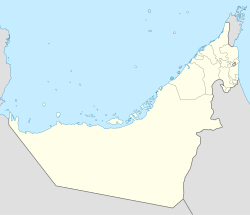
The Emirate of Fujairah is one of the seven emirates that make up the United Arab Emirates. The only of the seven with a coastline solely on the Gulf of Oman and none on the Persian Gulf, its capital is Fujairah.
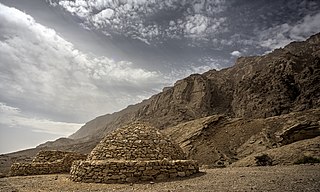
Jabal Hafeet is a mountain in the region of Tawam, on the border of the United Arab Emirates and Oman, which may be considered an outlier of Al Hajar Mountains in Eastern Arabia. Due to its proximity to the main Hajar range, the mountain may be considered as being part of the Hajar range, sensu lato. To the north is the UAE city of Al Ain, in the Eastern Region of the Emirate of Abu Dhabi, and the adjacent Omani town of Al-Buraimi.
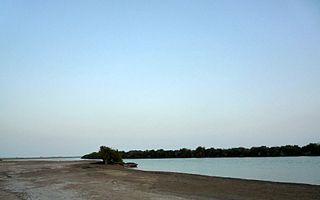
Kalba is a city in the Emirate of Sharjah in the United Arab Emirates (UAE). It is an exclave of Sharjah lying on the Gulf of Oman coast north of Oman. Khor Kalba, an important nature reserve and mangrove swamp, is located south of the town by the Omani border.

Dibba Al-Hisn is a pene-exclave of the emirate of Al-Sharjah, one of the seven United Arab Emirates. It is bordered by the Gulf of Oman from the East, Dibba Al-Baya from the North, and Dibba Al-Fujairah from the South. It is also geographically part of the Dibba region. It is the smallest in size among the Dibbas. It is mostly known for its fish market and the ancient fortress from which it got its name. Also, it is known for its high density of population relative to the other Dibbas.

Bithnah is a village in Fujairah, United Arab Emirates (UAE), long occupying a strategic location in the Wadi Ham, which is the only natural link to the interior of the UAE and the Persian Gulf from the East Coast city, and Emirate of Fujairah.

The Sheikh Zayed Mosque, Fujairah, is the main mosque in the Emirate of Fujairah, and the second largest in the United Arab Emirates (UAE) after the mosque with the same name in Abu Dhabi.
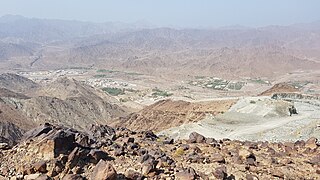
Wadi Ham is a wadi, a seasonal watercourse, in the Hajar Mountains of Fujairah and Ras Al Khaimah, United Arab Emirates.
The Kunud is a tribe of the United Arab Emirates (UAE) and Oman.
The UAE's Iron Age I spanned 1,200–1,000 BCE; Iron Age II, 1,000–600 BCE and Iron Age III from 600–300 BCE. This was followed by the Hellenistic Mleiha era, from 300 BCE onwards through to the Islamic era which commenced with the culmination of the 7th century Ridda Wars.
The territory currently known as the United Arab Emirates was home to three distinct Iron Age periods. Iron Age I spanned 1,200–1,000 BCE, Iron Age II from 1,000–600 BCE, and Iron Age III from 600–300 BCE. This period of human development in the region was followed by the Mleiha or Late Pre-Islamic era, from 300 BCE onwards through to the Islamic era which commenced with the culmination of the 7th century Ridda Wars.

Tourism in the United Arab Emirates is an important component of the Emirati economy, and consists of domestic and international components. In 2018, tourist industry composed over 164.7 billion dirham to country's GDP.

Wadi Hayl is a seasonal watercourse in the Hajar Mountains of Fujairah, in the United Arab Emirates. The wadi runs from the Fujairah industrial suburb of Al Hayl through the old village of Hayl and Hayl Fort, to reach the Wadi Helo.

Wadi Saham is a seasonal watercourse in the Hajar Mountains of Fujairah, in the United Arab Emirates. It is notable for its petroglyphs, including a single rock bearing 26 petroglyphs across four faces.

Al Hayl Fort is located in the Wadi Hayl, to the West of Fujairah, in the United Arab Emirates. Constructed in 1932 by Sheikh Abdullah bin Hamdan Al Sharqi, the fort formed his principle residence for the following two decades. Consisting of a fortified courtyard house and an associated watchtower with commanding views to the East and West of Wadi Hayl, Al Hayl Fort overlooks the old village of Al Hayl, of which many buildings have now been restored. The village was abandoned in the late 1970s following the resettlement of its inhabitants to a new village further down the wadi, a seasonal watercourse, and protected by the Al Hayl Dam. The village was traditionally settled by members of the Kunud tribe, with evidence that the area has been settled since the Umm Al Nar period, with Umm Al Nar tombs and Iron Age petroglyphs both found in the area. A number of these are now being threatened by ongoing construction in the area.

Wadi Siji is a seasonal watercourse in the Hajar Mountains of Fujairah, in the United Arab Emirates. The wadi runs from the Sharjah city of Dhaid to the mountain town of Masafi, where it meets the Wadi Ham and Wadi Abadila. It has long been a strategic route connecting the interior and East Coast of the UAE.

Wadi Helo is a seasonal watercourse located in the Hajar Mountains of Sharjah, in the United Arab Emirates. The wadi runs northwest to southeast of the eponymous village of Wadi Helo, located on the Sharjah-Kalba highway.

Wadi Ejili is a wadi, or seasonal watercourse, in the Hajar Mountains of Ras Al Khaimah, United Arab Emirates. It runs down from the confluence of the Wadi Shawka and Wadi Esfai to run into the Wadi Helo at the village of Fayyad, on the Sharjah-Kalba Highway (E102).
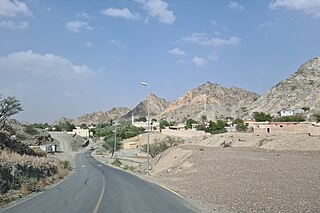
Tayyibah is a large village in the Hajar Mountains of Fujairah, United Arab Emirates. It is notable for its hiking trails, its Heritage Museum and the Al Qalaa Lodge, an Emirati heritage themed guest house.

Wadi Shie is a seasonal watercourse located in the Eastern Hajar Mountains of Sharjah, in the United Arab Emirates.

